 Maryland Department of Transportation Maryland Transit Administration (MDOT MTA) awarded Alstom an operations and maintenance contract (O&M) for MARC train fleet and facilities. The base term of the initial five-year contract with an agency budget of around EUR 367 million allows for two potential extensions in 2028 and 2033. In total, Alstom would carry out services for 15 years at a total value of around EUR 1.2 billion.
Maryland Department of Transportation Maryland Transit Administration (MDOT MTA) awarded Alstom an operations and maintenance contract (O&M) for MARC train fleet and facilities. The base term of the initial five-year contract with an agency budget of around EUR 367 million allows for two potential extensions in 2028 and 2033. In total, Alstom would carry out services for 15 years at a total value of around EUR 1.2 billion.
This agreement follows the 2012 award of the previous services contract and calls for Alstom’s continued operation and maintenance of the Maryland Area Rail Commuter (MARC) Camden and Brunswick Lines, which are 63 km and 119 km long, respectively.
Alstom will continue to be responsible for train operations, customer service, crewing, maintenance of the locomotives and railcar fleet, as well as station and facilities management. Alstom has acquired extensive experience and proven its expertise in maintaining MARC train fleet consisting of 42 diesel locomotives, 60 MARC II passenger cars, and 54 Alstom BiLevel coaches (the MultiLevel II MARC IV coaches). This includes daily inspection, equipment servicing, preventive and corrective maintenance at the Maryland Transit Administration’s MARC Train maintenance facilities.
“We are delighted to have the opportunity to strengthen our long and proud relationship with the Maryland Transit Administration, and very proud of our performance since we initiated services in 2013,” Michael Keroullé, Alstom Americas President said.
Under the broadened scope of this new contract, Alstom will continue operations and maintenance of the Camden and Brunswick Lines. In addition to piloting a fuel-saving project, this new scope also features some digital innovations that align with Alstom’s strategic plan to lead the way to smarter and more sustainable mobility.
Digital Twin is a virtualisation tool for facilities and equipment. It fosters efficiencies through reduced travel time, linked data and maintenance information, and enhanced training capabilities. 3D printing technology will be used to bring agility to certain maintenance activities and parts replacements. The Remote Assistance platform features connected glasses that will provide remote assistance, allowing real-time analysis and problem solving in the field by local and regional experts, regardless of location.
Share on:



